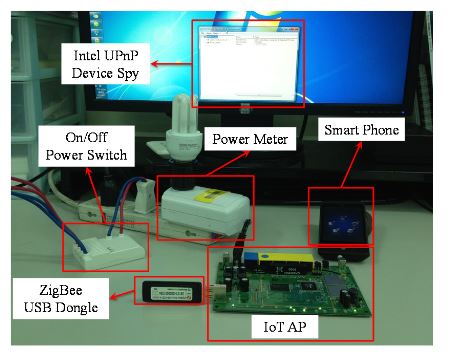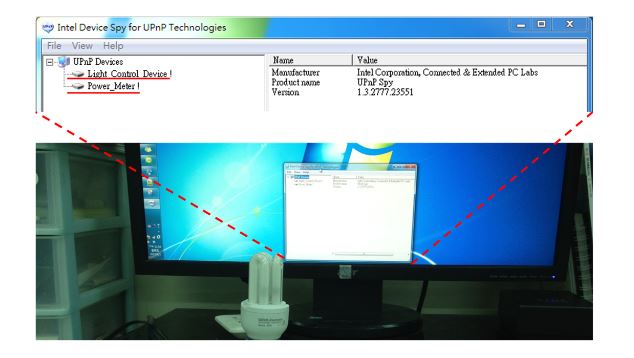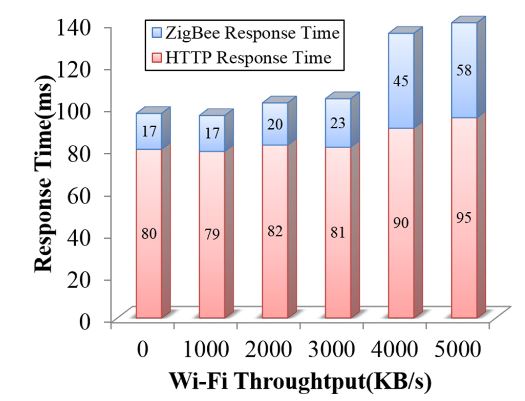ABSTRACT
Network communication and micro-electro-mechanical embedded technologies have attracted much attention in recent years. Through these technologies, the capabilities of sensing, identification, and communication can be embedded in various smart devices. These smart devices can automatically connect to the Internet and form an intelligent network called Internet of Things (IoT).
However, these devices are em bedded with different wireless communication interfaces such as Wi-Fi and ZigBee. This paper presents the design and implementation of an IoT access point that supports functionalities of coordination of various wireless transmission protocols. Based on the existing Wi-Fi access point, we have embedded a ZigBee module and implemented ZigBee and UPnP protocols into the designed IoT access point, which supports ZigBee communication capabilities over the Internet.
RELATED WORKS
The IoT supports various applications. Smart Life is one of the IoT supported applications that aims to make human beings’ lives more convenient. In literature, a large amount of papers had proposed the design and implementation of the IoT gateway. However, there are several differences between commercial IoT gateways and the developed IoT AP. The following presents the major differences.
SYSTEM ARCHITECTURE OF THE IOT AP

Figure 1. An Internet of Things (IoT) application: Smart Life scenario
Figure 1 depicts the application scenario of the IoT AP for smart life where three network types are considered. The first one is Ethernet, which allows an AP connecting to Internet; the second one is Wi-Fi, which provides Internet connection for handheld devices via an AP; the third one is ZigBee, which is characterized by low-power and commonly embedded in sensors for environmental monitoring or event detection.
SYSTEM IMPLEMENTATION OF IOT AP

Figure 3. The ZigBee Agent system architecture
Figure 3 depicts the system architecture of the developed ZigBee agent consisting of ZigBee modules, including the Serial Port Control Module, the Command Process Module, the ZigBee Device Management Module, the UPnP Device Management Module, the HTTP Command Process Module, the Channel Allocation Module, and Emergency Process Module. The details of module functionalities are elaborated in the next paragraph.

Figure 5. UPnP basic components diagram
Figure 5 depicts that a user controls UPnP devices through a smartphone. Initially, the UPnP software application is in stalled in the smartphone, namely the UPnP CP. It is responsible for searching and controlling the UPnP devices. In this situation, the UPnP device plays the role of a media server that provides streaming to execute the command for processing the CP. After a smartphone has discovered a multimedia server, it requests a media streaming.
BUILDING SMART HOME BY USING IOT AP

Figure 7. Smart Home system established by the IoT AP
As shown in Figure 7, this section explains the development of the proposed IoT AP to build a smart home application. This paper proposes the configuration of two ZigBee devices, which are the power meter and on/off power switch. These devices are sold by simple home net company and have been certified by the ZigBee Alliance.

Figure 10. Using Device Spy to find UPnP devices
This paper uses the desktop computer, notebook computer, and smart mobile phone connecting to the designed IoT AP through Wi-Fi and uses Device Spy to confirm whether or not the IoT AP broadcasts the ZigBee devices through the UPnP. As shown in Figure 10, two UPnP devices can be found by using the Device Spy. The device information can be obtained by clicking one of the devices.
IOT AP PERFORMANCE EVALUATION

Figure 13. The impact of Wi-Fi throughputs variation on the ZigBee response time
The probability and number of ZigBee packet collisions increase with the increment of Wi-Fi packets. Therefore, some ZigBee packets need to be re-sent, which increases the ZigBee response time. From Figure 13, we can conclude that the response time of ZigBee channel 15 is maintained to be less than 22 ms on any Wi-Fi throughputs.

Figure 15. The impact of Wi-Fi throughput variation on the command execution response time
As shown in Figure 15, when the Wi-Fi throughput ranges between 0 KBps and 3000 KBps, the total Wi-Fi response time has minimal impact. When the Wi-Fi throughput exceeds 3000 KBps, the HTTP response time and ZigBee response time are affected by background interference, which results in longer response time.
CONCLUSIONS
This paper proposes the integration of ZigBee communication, Wi-Fi communication, and Internet connection capabilities onto a traditional Wi-Fi AP by combining the AP with ZigBee standard. With the proposed approach, the original Wi-Fi AP can be upgraded to an IoT AP. The novelty and contribution of the proposed IoT AP is summarized below. (1) IoT AP adaptively provides negotiation of channel usages between Wi-Fi network and ZigBee networks and help ZigBee network to allocate channel in a shorter response time;
(2) Wi-Fi interference can compete with other Wi-Fi devices and reserve the allocated bandwidth resource for ZigBee network. This function fully resolves the existing problem of unbalanced resource competition between Wi-Fi and ZigBee interferences; (3) IoT AP supports dual modes of ZigBee operations, including power saving mode and emergency mode.
By reducing the frame size, the IoT AP provides ZigBee devices with more opportunities to transmit data in a short cycle; and (4) the data collected from IoT devices can be forwarded directly to the data server or data center via the Internet in a more efficient way, as compared with the existing solutions. This helps the IoT AP can save more energy consumptions and reduce the response time.
Source: Tamkang University
Authors: Chih-Yung Chang | Chin-Hwa Kuo | Jian-Cheng Chen | Tzu-Chia Wang
>> IoT Software Projects for Final Year Students
>> More Wireless Embedded Projects for Final Year Students